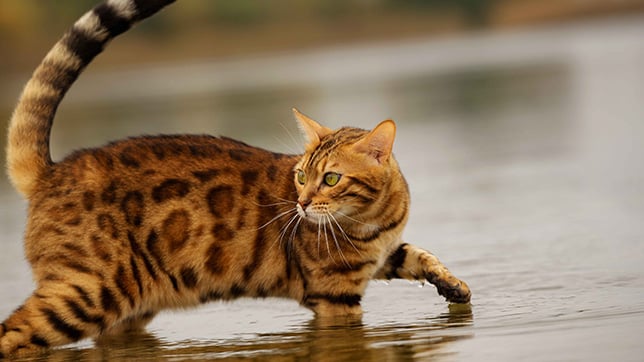23rd October 2021
Find out why some cats are scared of water
When it comes to cats and water, it’s a common assumption that all felines hate swimming. Some people might be shocked if they saw a cat voluntary splashing around in the bath, however you may be surprised to learn that not all cats hate water and some will try to jump in!
In this guide, we’ve shared some of the cat breeds that love splashing in water, along with some safety tips to ensure that they don’t become ill from swimming:
What cat breeds like water?
Although not all felines dislike being in water, certain breeds love swimming more than others. In fact, some cats have the build that makes them great natural swimmers once they get in!
Turkish Vans are one breed of cat that loves swimming, hence why they’re often referred to as the ‘swimming cat’. This type of cat has a body built for swimming with their long frames and rounded paws.
Maine Coons are also a big fan of swimming, even though they’re one of the biggest domestic breeds! Their robust bodies are suitable for holding themselves in water and they’ve even been known to scoop water with their paws. If you’ve got a Maine Coon, you may have spotted them trying to do this from the toilet!
Bengals are great swimmers too, and as they derive from Asian Leopard Cats, they still have their natural instinct to splash and play in water.

Reasons for disliking water
Even though certain cats love swimming, there are still many cats that will shiver at the sight of a bath! The reasons why cats hate swimming vary, although these are the most common:
Heavy coats
If your cat is long-haired and they start swimming, their coat may become too heavy and make staying afloat a struggle. Cats’ fur isn’t water-resistant, meaning they feel less secure in water, as they aren’t as agile.
Cold
Another reason why your cat may hate water is because their body temperature drops drastically. As domestic short hairs generally have little fur, the water can get directly to their skin and make them feel too cold and therefore, desperate to get out of the water.
Sensitive to odours
Cats are also extremely sensitive to odours, which is why some don’t like swimming outdoors. They may be put off the scent of the water or the chemicals in it – and may also be the reason your cat won’t drink tap water.
Safety tips for cat swimming
If your cat loves swimming, there are a few water safety tips to make sure that they don’t catch a waterborne illness or injure themselves:
- Always keep an eye on your cat in water and take them out if you suspect that they’re struggling to keep afloat
- Clean your cats’ ears after they’ve been swimming to prevent an infection
- Never let your cat drink water from a swimming pool. This could cause disturbance to their stomach.
Whilst many cats like water, you should never force your cat to swim and always keep an eye out for their safety when around water. Remember that having cat insurance will help you to protect your feline against any water injuries or illnesses, helping them get back into perfect shape and back to swimming in no time!
Looking for more cat advice?
We’ve written some handy cat advice guides, to help you unlock the secrets of your mysterious moggy.
Need cat insurance?
Cat insurance can help cover the cost of veterinary treatment if your cat gets injured or falls ill.
We know pets
Our pets are part of the family. To achieve our vision of a better future for pets everywhere, we work with our partners, vets, and other veterinary professionals who are pioneering the latest advancements in animal care. Our campaigns, articles, and events are crafted to support, educate, and celebrate pet owners, while our policies are designed to provide peace of mind at an affordable price.
Yet our policies don’t just protect against the unexpected – they have purpose, too.
Since we were founded over 25 years ago, we've provided industry-leading policies that protect the nation’s pets, while also making a difference to animal welfare and our planet. Thanks to you, our policyholders, we've donated over £9 million to more than 830 animal welfare charities and conservancies, helping to support vulnerable pets and wildlife around the world.
We’re proud to be wildly different. Are you?
